Acting commander of USS Theodore Roosevelt aircraft carrier blames Donald Trump for sacking of captain Brett Crozier over coronavirus email - and says it was like 'dropping a nuclear bomb' on the crew
The dismissed captain of the USS Theodore Roosevelt claims he knew he was likely ending his military career when he sent his now infamous email warning to top Navy officials about the coronavirus outbreak on board.
Navy Capt. Brett Crozier, 50, said that he knew the 'red flare' would jeopardize his position when he broke protocol in sending the letter, but he felt it had to be done to save lives aboard the ship as the outbreak worsened.
In a witness statement Crozier made in May obtained by the San Francisco Chronicle, he said he felt compelled to take action as part of an urgent effort to help avoid a 'larger catastrophe'.
Recorded during the Navy's investigation into his dismissal, the statement outlines Crozier's thinking when he sent the March email that upended the military world.

Navy Capt. Brett Crozier, 50, said that he knew the 'red flare' would jeopardize his position when he broke protocol in sending letter warning of the worsening conditions of the coronavirus outbreak onboard his ship the USS Theodore Roosevelt in March

USS Theodore Roosevelt finally arrives back in San Diego after seven months at sea, a COVID outbreak and an ousted captain. In a witness statement made in May Capt. Brett Crozier said that he knew he could possibly end his career with a letter to top brass about the outbreak
Crozier was hit with condemnation for the letter from the top Navy admiral overseeing the nuclear aircraft carrier and also faced criticism from President Donald Trump.
Crozier, a native of Santa Rosa, California, was stripped of his position in early April but received a rousing hero's sendoff from his crew, who credited him with saving their lives.
A frustrated Crozier sent the letter on March 30, saying that more needed to be done to remove 5,000 sailors from the carrier docked in Guam.
More than 1,200 sailors, more than one in five, eventually tested positive for the virus, including Crozier, who spent a month in Guam in isolation.
Several were hospitalized and one died from COVID-19 complications.
Crozier said he sent the email through unclassified channels because of quickly worsening conditions that demanded urgent action.
Navy officers said that led to the memo being leaked and jeopardized sensitive talks with Guam officials to house sailors in hotel rooms.
They said he was removed for poor handling of the breakout and for going outside the chain of command.
'My intent in sending the email... was to bring a sense of urgency to a rapidly deteriorating and potentially deadly situation onboard the (Theodore Roosevelt) and avoid a larger catastrophe and loss of life,' Crozier said in the witness statement.

USS Theodore Roosevelt arriving back to San Diego after the outbreak onboard

'From my perspective, even just one more week of routine planning would have resulted in another week of exponential growth in positive cases and greater risk to more Sailors. We wanted to stop the administrative bureaucracy... so I sent up a red flare,' he said.
The conditions on board the Roosevelt became public when the San Francisco Chronicle reported on the email.
According to the Chronicle, the investigation into Crozier's dismissal showed that much of Crozier's crew was fiercely loyal to the captain and suspicious of his firing.
Some even questioned if he had only been fired because of Trump's criticism.
'I feel (Crozier) was willing to fall on his sword to show that appropriate actions were not being taken. ... I think that he was relieved because of a political decision by Modly or possibly at the OSD/POTUS level,' said Roosevelt Executive Officer Capt. Daniel Keeler in his witness statement.
He added that the captain's dismissal was like 'dropping a nuclear bomb in the middle of an ongoing crisis'.

Capt. Brett Crozier had the support of much of his crew despite his dismissal

Theodore Roosevelt's COVID-negative crew returned from quarantine beginning on April 29 and began making preparations to return to sea, as pictured
Crozier's bosses were extremely critical of his actions, however.
Vice Admiral William Merz, commander of the U.S. Seventh Fleet, told investigators that Crozier either did not understand military efforts underway to evacuate the crowded ship or wanted to undermine those efforts.
Merz hypothesized that Crozier screwed up and panicked, or wanted to play hero.
'Based on the regular and timely feed of information to him and his team, either he wasn't listening, could not comprehend, or maliciously undermined the response,' Merz told investigators.
'When he did act, he did so in a way arguably the most inappropriate possible and in spite of all other avenues being available. All fatal flaws — not fit for command.'
'Either way, he surrendered, and brings into question his resiliency and toughness in command,' Merz added.
In April, the Navy recommended Crozier's reinstatement but after a deeper investigation the decision was made in June to maintain his dismissal.
Officials said he could only be reassigned and was ineligible for future command posts.
In his May 8 witness statement, Crozier described how the first three cases were found on board in mid-March, beginning 'Bleachapalooza' in an attempt to prevent the outbreak worsening.

Sailors from the USS Theodore Roosevelt who have tested negative for coronavirus and are asymptomatic carry food supply boxes for sailors at local hotels in an effort to implement social distancing and stop the spread of the virus in Guam

There was a twice daily scrubbing with all hands, and infected sailors and those with close contacts were isolated in the aft of the ship.
The captain would later be criticized for prematurely releasing sailors from that quarantine zone, possibly spreading the virus among the rest of the ship.
However, his second in command, Keeler, said the spread had already taken hold.
'We had some true human suffering in aft berthing. Conditions were poor,' Keeler told investigators. 'I regret attempting it and would not do it again.'
As conditions worsened, Crozier said he was told to expect a call from Chief of Naval Operations Adm. Michael Gilday on March 28, but the call was canceled.
'The phone call might have provided a more thorough understanding of wider Navy efforts to combat the virus onboard and with our crew, allowed me to communicate our desire to get Sailors into effective isolation quarters ashore, and instilled confidence that the situation was being rapidly addressed at the appropriate levels,' Crozier told investigators.
By March 30 he was too frustrated not to take action, he said.
'I believe everyone involved was well intentioned, but some up the chain of command were proceeding more slowly than I would have liked and getting unnecessarily wrapped up in the status quo of (plan) development,' he said.
'From my perspective, even just one more week of routine planning would have resulted in another week of exponential growth in positive cases and greater risk to more Sailors. We wanted to stop the administrative bureaucracy ... so I sent up a red flare.'
When he was dismissed, Crozier was told it happened not because he asked for help but because he broke the chain in command.
Yet Crozier argued he sent the email through unclassified channels because speed was of the essence at that time and quicker to read than on a government smartphone.
'(Merz's) staff was still trying to bound the problem, and information flow there suggested they might see the email as a hindrance to normal staff work (versus) see it as a red flare,' Crozier told investigators.
'In hindsight, there was no good reason for not including (Merz) and I suspect that he would have been as responsive as everyone else was.'
Crozier was dismissed from command April 3 after a phone call with Secretary of the Navy Thomas Modly who was upset the cpatain hadn't 'reached out to him personally about my continuing concerns'.
He said that Modly visited him in quarantine in Guam and said he relieved him of duty because 'he lost trust and confidence in me.'
Crozier has been temporarily reassigned to San Diego, where he will serve as the special assistant to the Naval Air Forces chief of staff.